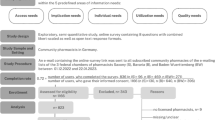Abstract
Background
In the European Union (EU), all medicines are mandated to be provided with a patient information leaflet (PIL). Many patients express concerns about the length and complexity of some PILs, and this can be a disincentive for patients to read the PILS. In order to address this, the UK’s regulatory body (Medicine and Healthcare products Regulatory Agency [MHRA]) suggested leaflets might include a headline section—information presented prominently at the beginning of a leaflet that summarizes key safety messages about a drug.
Objective
To explore the extent to which readers used a headline section in a PIL, using a form of diagnostic testing called user-testing, which examines how readers find and understand key information.
Methods
The study used a cross-sectional design to user-test a PIL with a headline section in a target sample of 20 participants. Participants were provided with an exemplar PIL, and the performance of the PIL was evaluated by a questionnaire and semistructured interview.
Results
The results showed that a headline section was used just over one-third of the time (39%); 90% of participants used the headline section to find information when they initially began the user-test. The qualitative findings suggested that the participants valued the presence of the headline section.
Conclusion
The research suggests there does not appear to be any negative impact from including a headline section in a PIL, and it is a technique that is highly valued by the consumers of medicines information.
Similar content being viewed by others
References
Raynor DK. Testing, Testing: The benefits of user-testing package leaflets. PIPA Newslett. 2008;86:4–5.
Medicines and Healthcare Products Regulatory Agency. Always Read the Leaflet: Getting the Best Information With Every Medicine. Report of the Committee on Safety of Medicines, Working Group on Patient Information. London: The Stationery Office; 2005.
Raynor DK, Blenkinsopp A, Knapp P, et al. A systematic review of quantitative and qualitative research on the role and effectiveness of written information available to patients about individual medicines. Health Technol Assess (Winchester, Engl). 2007;11(5):iii.
Raynor DK, Silcock J, Knapp P, Edmondson H. How do patients use medicine information leaflets in the UK? Int J Pharm Pract. 2007;15(3):209–218.
Hartley J, Truman M. The effects of summaries on the recall of information from prose text. Human Learn. 1982;1:63–82.
Hartley J. Designing instructional and informational text. In: Jonassen D, ed. Handbook of Research on Educational Communications and Technology: A Project of the Association for Educational Communications and Technology. New York: Taylor & Francis Group; 2004.
Raynor DK. User testing in developing patient medication information in Europe. Res Soc Admin Pharm. 2013;9(5):640–645.
Dolk S, Lentz L, Knapp P, Maat HP, Raynor T. Headline section in patient information leaflets: Does it improve reading performance and perception? Inform Design J. 2011;19(1):46–57.
Dickinson RJ. The Inclusion of a Headline Section and Information About the Benefits of Medicines in Written Medicines Information [PhD thesis]. Leeds, UK: University of Leeds; 2014.
Sless D, Shrensky R. Writing About Medicines for People. 3rd ed. Sydney: Australian Self Medication Industry; 2007.
Raynor DK, Knapp P, Silcock J, Parkinson B, Feeney K. “User-testing” as a method for testing the fitness-for-purpose of written medicine information. Patient Educ Counsel. 2011;83(3):404–410.
Medicines and Healthcare Products Regulatory Agency. Always Read the Leaflet: Getting the Best Information With Every Medicine. London: The Stationary Office; 2005.
Medicines and Healthcare products Regulatory Agency. Best Practice Guidance on Patient Information Leaflets. London: Medicines and Healthcare products Regulatory Agency; 2012.
European Commission. Guideline on the Readability of the Labelling and Package Leaflet of Medicinal Products for Human Use. Vol Revision 1, January 12, 2009. Brussels: European Commission; 2009.
Co-ordination Group for Mutual Recognition and Decentralized Procedures—Human. CMDh annotated QRD template for MR/DC procedures (based on version 8 of the QRD template for CP). 2011. http://www.hma.eu/uploads/media/QRD_annotated_template_CMDh.pdf. Accessed March 4, 2013.
Dixon-Woods M. Writing wrongs? An analysis of published discourses about the use of patient information leaflets. Soc Sci Med. 2001;52(9):1417–1432.
Grime J, Blenkinsopp A, Raynor DK, Pollock K, Knapp P. The role and value of written information for patients about individual medicines: A systematic review. Health Expect. 2007;10(3):286–298.
European Commission. Directive 2004/27/EC of the European Parliament and of the Council of 31 March 2004 amending Directive 2001/83/EC on the Community code relating to medicinal products for human use (Text with EEA relevance). Official Journal L 136, 30/04/2004 P. 0034-0057; 2004.
Knapp P, Raynor DK, Silcock J, Parkinson B. Performance-based readability testing of participant information for a Phase 3 IVF trial. Trials. 2009/09/01 2009;10(1):1–15.
Jay E, Aslani P, Raynor D. User testing of consumer medicine information in Australia. Health Education Journal. 2010;70(4):420–427.
Author information
Authors and Affiliations
Corresponding author
Rights and permissions
About this article
Cite this article
Dickinson, R., Raynor, D.K., Knapp, P. et al. Do Patients Use a Headline Section in a Leaflet to Find Key Information About Their Medicines? Findings From a User-Test Study. Ther Innov Regul Sci 50, 581–591 (2016). https://doi.org/10.1177/2168479016639080
Received:
Accepted:
Published:
Issue Date:
DOI: https://doi.org/10.1177/2168479016639080



